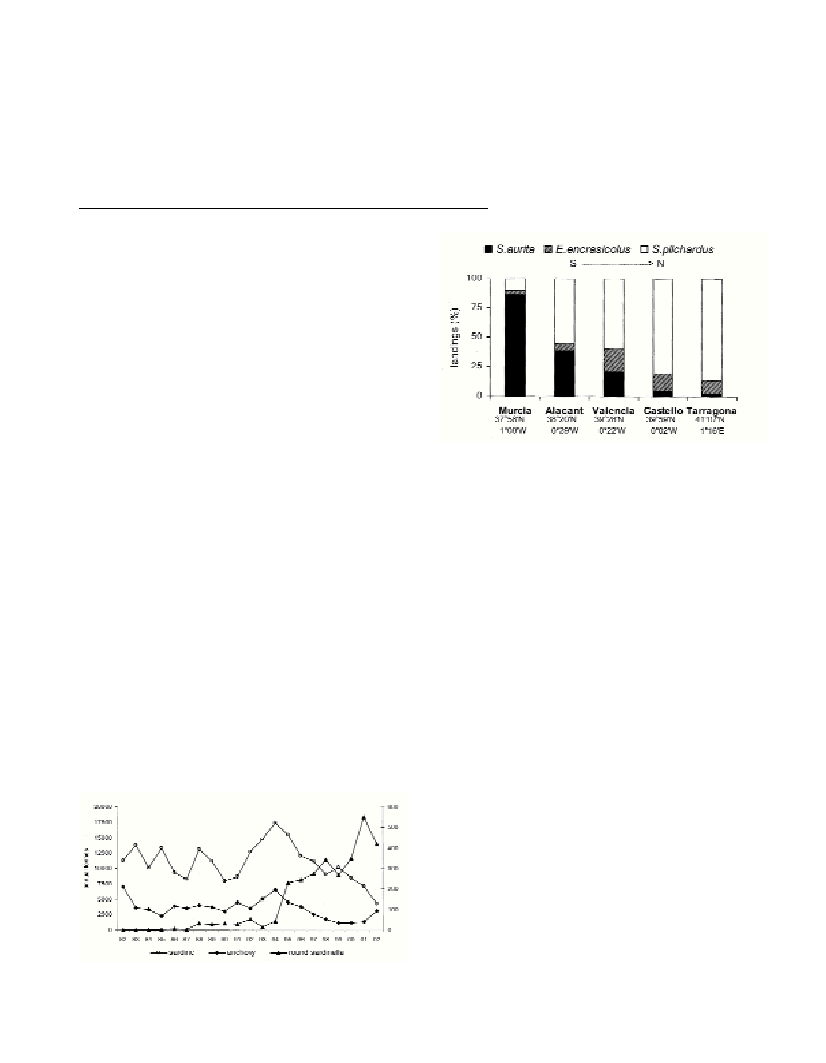INCREASING ABUNDANCE OF THE ROUND SARDINELLA, SARDINELLA AURITA,
RELATED TO THE WARMING TREND IN THE NW MEDITERRANEAN
P. Martín
*
and A. Sabatés
ICM-CSIC, Barcelona, Spain - * paloma@icm.csic.es
Abstract
In the last decade a marked increase in the abundance of the warm water pelagic species Sardinella auritahas been observed, following
the warming of the NW Mediterranean waters. From the distribution of commercial landings along a latitudinal gradient, the possible
replacement of Sardina pilchardusby Sardinella auritais brought up.
Key words: Sardinella aurita, stock ?uctuations, temperature, NW Mediterranean
Rapp. Comm. int. Mer Médit., 37,2004
396
Introduction
In the NW Mediterranean, an increase in the annual mean sea
temperature has been recorded. This increase has been, during the last
25 years, of 0,7
°
C at surface, and of 0,4
°
C at 80 m depth (1); and,
between 1959 and 1989, of 0,12
°
C at >400 m depth (2). Furthermore,
the distribution range of fishes and benthic organisms characteristic of
warm waters has expanded (e.g. 3), and their presence is more and
more frequent in the northern part of the sea. Conversely, the
abundance of boreal species has dramatically decreased since the
1980’s (4), suggesting a process of tropicalization of NW Mediter-
ranean. At a large scale, variations in the geographic limits of the
distribution are the most immediate effect of the global warming on
the icthyofauna, resulting to both local extinctions and invasions by
allochthonous species from warmer or tropical environments. This
effect is likely to be observed on those populations located at the
boundaries of the species geographical distribution. Round sardinella,
Sardinella aurita,is a thermophilous small pelagic species, having a
tropical to subtropical distribution in the Mediterranean and Eastern
Atlantic coasts, particularly sensitive to temperature changes (5).
S.auritawas known to complete its full biological cycle off the
Catalan coast at least since the early 1980’s (6).
Results
Sardine (Sardina pilchardus) and anchovy (Engraulis encra-
sicolus), are the main target species for the purse seine ?eet,
accounting for the highest catches off the Catalan coast. However,
S.auritalandings have increased in the last decade, implying that the
species is more abundant in the area (Fig. 1). It is worth mentioning
that in coincidence with the S. auritaabundance increase, a
decreasing trend in the landings of S. pilchardusand E.encrasicolus
has been observed, especially for sardine. In the case of anchovy, the
most intensively exploited small pelagic species off the Catalan coast,
this trend ended by 1999, probably explained by varying fishing
pressure.
S. auritais particularly abundant in the southern Mediterranean, its
abundance gradually decreasing northwards. The differences in
species abundance are linked to the latitudinal pattern of the sea
surface temperature (7). Along a latitudinal gradient in the Spanish
Mediterranean coast, the proportion of this species in the 2001 purse
seining landings was much higher in the southern ports, where sardine
presence was lower, decreasing northwards (Fig. 2). Altogether seems
to indicate that a replacement of sardine by round sardinella would be
taking place in the NW Mediterranean. At present, there is no
evidence for competition between these two species in the study area.
Our results show that S. auritagradually spreads northwards.The
observed changes in the geographical distribution and abundance of S.
auritain the last years suggest a trend in the long term, consequence
of global warming, and would not be only a response to interannual
variability.
References
1-Salat J., and Pascual, J., 2002. The oceanographic and meteorological
station at l’Estartit (NW Mediterranean). Tracking longt-erm hidrological
change in the Mediterranean Sea. CIESM Workshop. Series, 16: 29-32.
2-Bethoux J.P., Gentili B, Raunet J., and Tailliez D., 1990. Warming
trend in the western Mediterranean deep water. Nature,347:660-662.
3-Francour P., Boudouresque C.F., Harmelin J.G., Harmelin-Vivien M.,
and Quignard J.P., 1994. Are the Mediterranean waters becoming
warmer? Information from biological indicators. Mar. Poll. Bull., 28: 523-
626.
4-Quignard J.P., Raibaut A., 1993. Ichthyofaune de la côte langue-
docienne (Golfe du Lion). Modifications faunistiques et démographiques.
Vie et Milieu,43:191-195.
5-Guidetti P., Boero F., and Dulcic J., 2002. Mass mortality of gilt
sardine, Sardinella aurita(Clupeidae), in the Adriatic and Ionian Seas.
Cybium,26: 317-319.
6-Palomera I., and Sabatés A., 1990. Co-occurrence of Engraulis
encrasicolusand Sardinella auritaeggs and larvae in the Northwestern
Mediterranean. Sci. Mar., 54: 63-69.
7-Climatological Atlas of the Mediterranean Sea. Scientific Report of the
MAST-MOBD initiative for ocean data and information management.
Contract number MAS2.0093.0075.BE (http://modb.oce.ulg.ac.be/atlas/
atlas.html).
Fig.1. Annual landings from five fishing ports along the Catalan coast
(data from the fishermen’s associations and the autonomous government
statistics; sardine and anchovy left axis, round sardinella right axis).
Fig.2. Small pelagics landings along the Spanish Mediterranean coast
(in percentage of the 2001 landings; data from different autonomous gov-
ernment’s statistics).

